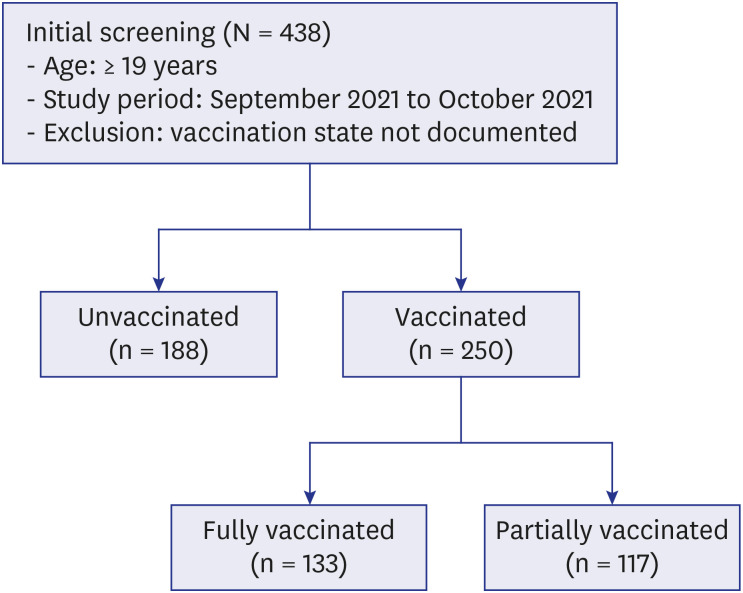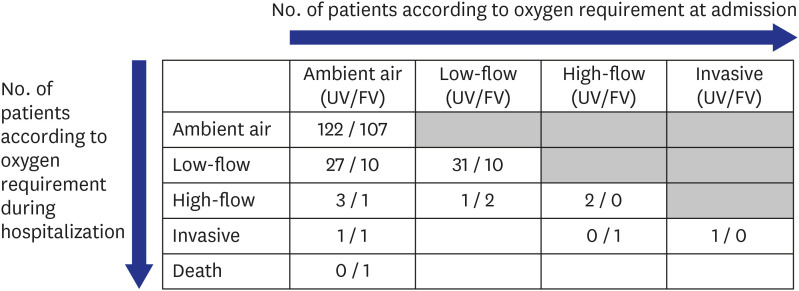J Korean Med Sci.
2022 Aug;37(32):e252. 10.3346/jkms.2022.37.e252.
Breakthrough COVID-19 Infection During the Delta Variant Dominant Period: Individualized Care Based on Vaccination Status Is Needed
- Affiliations
-
- 1Department of Internal Medicine, Seoul National University College of Medicine, Seoul, Korea
- 2Department of Internal Medicine, Seoul Metropolitan Government-Seoul National University Boramae Medical Center, Seoul, Korea
- 3Division of Infectious Diseases, Department of Internal Medicine, Seoul National University Bundang Hospital, Seongnam, Korea
- KMID: 2532326
- DOI: http://doi.org/10.3346/jkms.2022.37.e252
Abstract
- Background
The clinical features of coronavirus disease 2019 (COVID-19) patients in the COVID-19 vaccination era need to be clarified because breakthrough infection after vaccination is not uncommon.
Methods
We retrospectively analyzed hospitalized COVID-19 patients during a delta variantdominant period 6 months after the national COVID-19 vaccination rollout. The clinical characteristics and risk factors for severe progression were assessed and subclassified according to vaccination status.
Results
A total of 438 COVID-19 patients were included; the numbers of patients in the unvaccinated, partially vaccinated and fully vaccinated groups were 188 (42.9%), 117 (26.7%) and 133 (30.4%), respectively. The vaccinated group was older, less symptomatic and had a higher Charlson comorbidity index at presentation. The proportions of patients who experienced severe progression in the unvaccinated and fully vaccinated groups were 20.3% (31/153) and 10.8% (13/120), respectively. Older age, diabetes mellitus, solid cancer, elevated levels of lactate dehydrogenase and chest X-ray abnormalities were associated with severe progression, and the vaccination at least once was the only protective factor for severe progression. Chest X-ray abnormalities at presentation were the only predictor for severe progression among fully vaccinated patients.
Conclusion
In the hospitalized setting, vaccinated and unvaccinated COVID-19 patients showed different clinical features and risk of oxygen demand despite a relatively high proportion of patients in the two groups. Vaccination needs to be assessed as an initial checkpoint, and chest X-ray may be helpful for predicting severe progression in vaccinated patients.
Figure
Reference
-
1. Polack FP, Thomas SJ, Kitchin N, Absalon J, Gurtman A, Lockhart S, et al. Safety and efficacy of the BNT162b2 mRNA COVID-19 vaccine. N Engl J Med. 2020; 383(27):2603–2615. PMID: 33301246.
Article2. Baden LR, El Sahly HM, Essink B, Kotloff K, Frey S, Novak R, et al. Efficacy and safety of the mRNA-1273 SARS-CoV-2 vaccine. N Engl J Med. 2021; 384(5):403–416. PMID: 33378609.
Article3. Falsey AR, Sobieszczyk ME, Hirsch I, Sproule S, Robb ML, Corey L, et al. Phase 3 safety and efficacy of AZD1222 (ChAdOx1 nCoV-19) COVID-19 vaccine. N Engl J Med. 2021; 385(25):2348–2360. PMID: 34587382.
Article4. Yi S, Kim JM, Choe YJ, Hong S, Choi S, Ahn SB, et al. SARS-CoV-2 delta variant breakthrough infection and onward secondary transmission in household. J Korean Med Sci. 2022; 37(1):e12. PMID: 34981682.
Article5. Wi YM, Kim SH, Peck KR. An outbreak of breakthrough infections by the SARS-CoV-2 delta variant in a psychiatric closed ward. J Korean Med Sci. 2022; 37(4):e28. PMID: 35075827.
Article6. Tang P, Hasan MR, Chemaitelly H, Yassine HM, Benslimane FM, Al Khatib HA, et al. BNT162b2 and mRNA-1273 COVID-19 vaccine effectiveness against the SARS-CoV-2 delta variant in Qatar. Nat Med. 2021; 27(12):2136–2143. PMID: 34728831.
Article7. Lopez Bernal J, Andrews N, Gower C, Gallagher E, Simmons R, Thelwall S, et al. Effectiveness of COVID-19 vaccines against the B.1.617.2 (delta) variant. N Engl J Med. 2021; 385(7):585–594. PMID: 34289274.
Article8. Lin DY, Gu Y, Wheeler B, Young H, Holloway S, Sunny SK, et al. Effectiveness of COVID-19 vaccines over a 9-month period in North Carolina. N Engl J Med. 2022; 386(10):933–941. PMID: 35020982.
Article9. Lambden S, Laterre PF, Levy MM, Francois B. The SOFA score-development, utility and challenges of accurate assessment in clinical trials. Crit Care. 2019; 23(1):374. PMID: 31775846.
Article10. Charlson ME, Pompei P, Ales KL, MacKenzie CR. A new method of classifying prognostic comorbidity in longitudinal studies: development and validation. J Chronic Dis. 1987; 40(5):373–383. PMID: 3558716.
Article11. Suh HJ, Kim DH, Heo EY, Lee HW, Lee JK, Lee CS, et al. Clinical characteristics of COVID-19: clinical dynamics of mild severe acute respiratory syndrome coronavirus 2 infection detected by early active surveillance. J Korean Med Sci. 2020; 35(32):e297. PMID: 32808513.
Article12. Korea Disease Control and Prevention Agency. Global trends and characteristics of the SARS-CoV-2 delta variant. Public Health Wkly Rep. 2021; 14(33):2363–2365.13. Korea Disease Control and Prevention Agency. July 2021 status and characteristics of the COVID-19 variant virus outbreak in the Republic of Korea. Public Health Wkly Rep. 2021; 14(48):3388–3396.14. Sun J, Zheng Q, Madhira V, Olex AL, Anzalone AJ, Vinson A, et al. Association between immune dysfunction and COVID-19 breakthrough infection after SARS-CoV-2 vaccination in the US. JAMA Intern Med. 2022; 182(2):153–162. PMID: 34962505.
Article15. Tenforde MW, Self WH, Adams K, Gaglani M, Ginde AA, McNeal T, et al. Association between mRNA vaccination and COVID-19 hospitalization and disease severity. JAMA. 2021; 326(20):2043–2054. PMID: 34734975.
Article16. Sieswerda E, de Boer MG, Bonten MM, Boersma WG, Jonkers RE, Aleva RM, et al. Recommendations for antibacterial therapy in adults with COVID-19 - an evidence based guideline. Clin Microbiol Infect. 2021; 27(1):61–66. PMID: 33010444.
Article17. Shin DH, Kang M, Song KH, Jung J, Kim ES, Kim HB. A call for antimicrobial stewardship in patients with COVID-19: a nationwide cohort study in Korea. Clin Microbiol Infect. 2021; 27(4):653–655. PMID: 33137513.
Article
- Full Text Links
- Actions
-
Cited
- CITED
-
- Close
- Share
- Similar articles
-
- Descriptive analysis of the incidence rate of post-acute COVID-19 syndrome in the Republic of Korea Army
- An Outbreak of Breakthrough Infections by the SARS-CoV-2 Delta Variant in a Psychiatric Closed Ward
- Effectiveness of the COVID-19 vaccine in the Honam region of the Republic of Korea
- Emergence of the Delta and Omicron Variants of COVID-19 Clusters in a Long-term Care Hospital, Seoul, Korea: Focusing on Outbreak Epidemiology, Incidence, Fatality, and Vaccination
- SARS-CoV-2 Delta Variant Breakthrough Infection and Onward Secondary Transmission in Household



